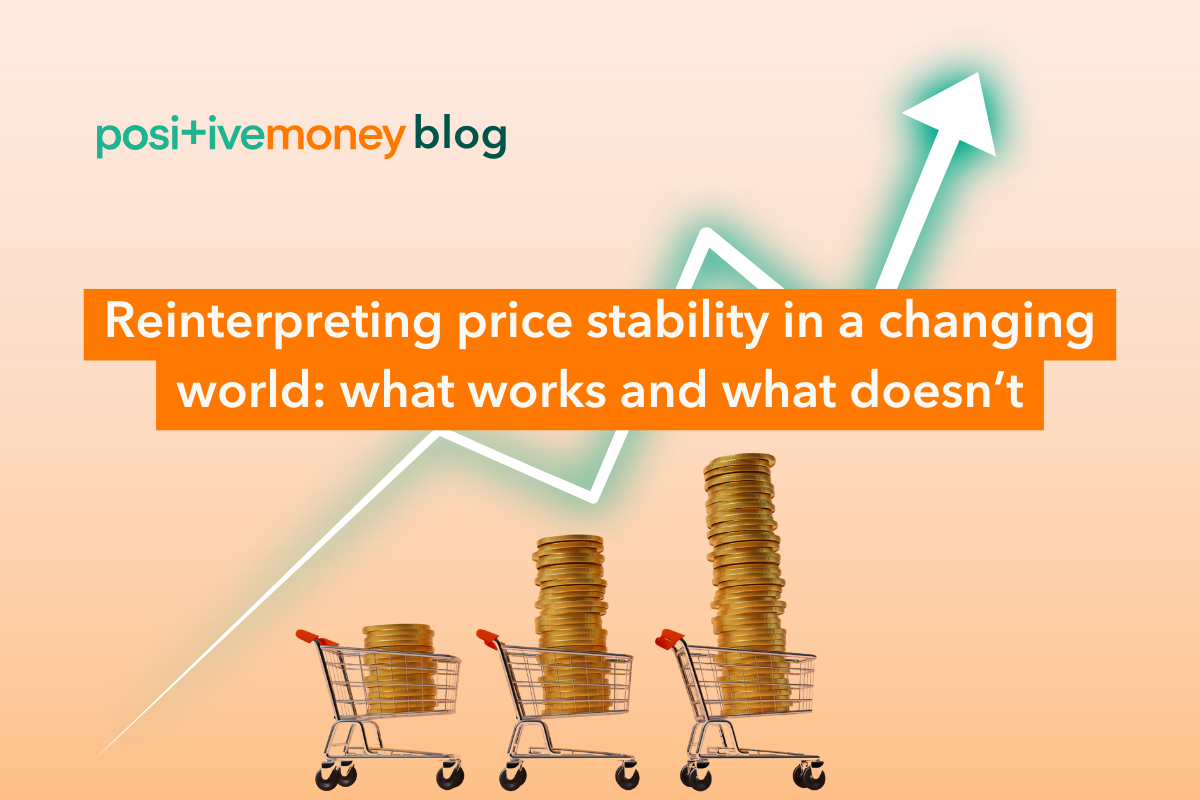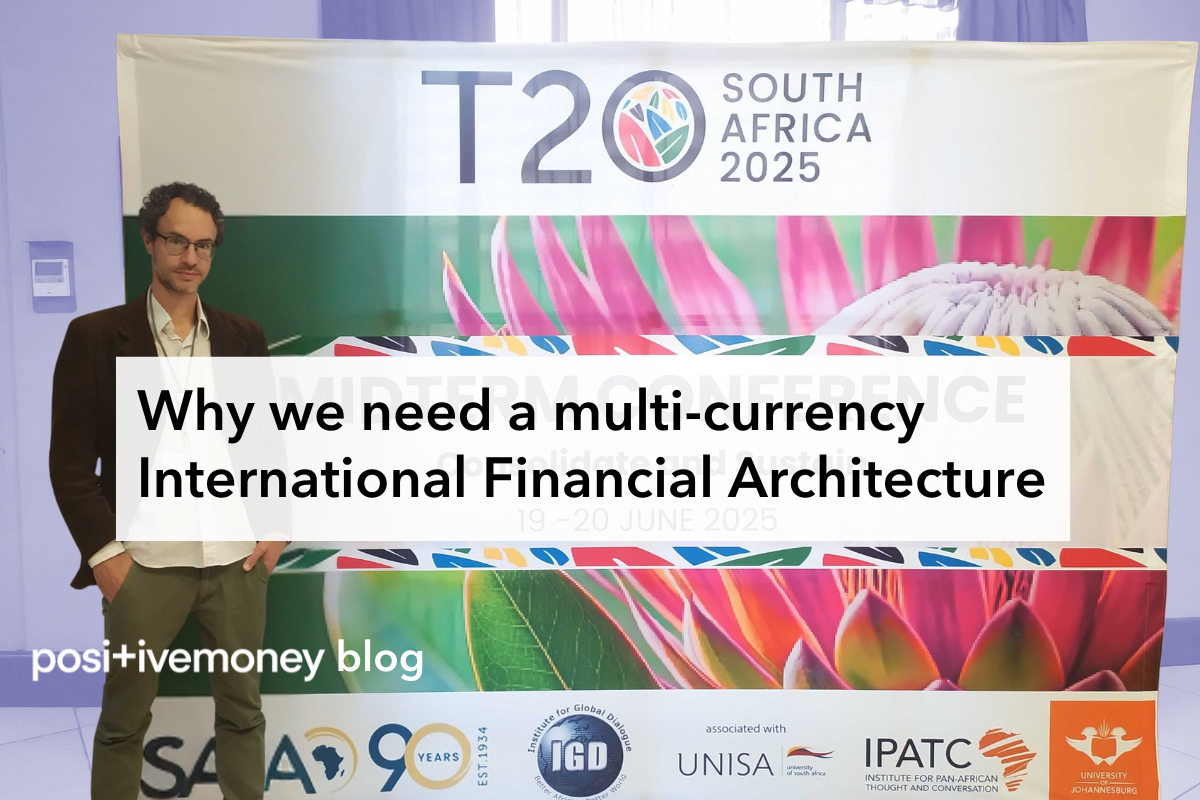
MacroeconomicsEU
18 December 2025
At the recent T20 summit in South Africa — where policy ideas are decided ahead of the G20 — our Senior Researcher, Bruno De Conti, co-led Taskforce 3 on Financing for Sustainable Development. In a huge win, Positive Money’s proposal for a multi-currency International Financial Architecture was endorsed by the taskforce and included in its final communiqué to G20 leaders! This blog explains why moving beyond reliance on a single dominant currency is essential to tackling global inequality, and how local currency alternatives can help empower the Global South.
The Group of 20 (G20), composed of the world's 19 richest countries and two regional bodies (the European Union and the African Union), is one of the most important forums for discussions on the global economy. As part of its activities, the G20 commissions the T20 (a group of think tanks, research institutes and experts from G20 countries) to organise debates and make recommendations on critical topics related to the economy and the environment. Invited by the T20 South Africa coordinators to participate in Taskforce 3 (Financing for Sustainable Development), in late June we headed to Pretoria in South Africa, to join the T20 Midterm Conference and make our call for change clear.
The world economy is shaped by all kinds of inequalities. From the characteristics of the labour market to the quality of infrastructure; from the level of average wages to the degree of food security. One crucial dimension of these inequalities is sometimes off the radar of the general public, but it is crucial to apprehend: the unequal status of national currencies on the world stage.
As a matter of fact, out of all transactions made in the global foreign exchange market, 88% use the US dollar. This far outweighs the US economy's share of the global pie (currently, US GDP is around 25% of the world GDP). On the other side of the spectrum, currencies issued by Global South countries have very minor usage at the international level. This means therefore that for international trade, external loans, and all kinds of cross-border transactions, these countries cannot rely on their own currencies, but have to use a hard currency - usually, the US dollar.
More details about these asymmetries of the International Monetary and Financial System can be found in our report “Beyond Dollar Dominance”. The critical issue is that these asymmetries reinforce all inequalities that have been mentioned above.
On the one hand, the USA retains what former French president Valérie Giscard d’Éstaing named as an “exorbitant privilege” in the 1960s. This refers to the way the US can have a structural deficit in its current account - meaning that it can buy much more in terms of goods and services from the rest of the world than it provides to them in return. In addition, it pays very little for its debt; it has minor external constraints for its monetary and fiscal policy; and several other advantages.
On the other hand, all other countries of the world - and especially Global South countries - have important risks and obstacles arising from this dollar hegemony.
As a matter of fact, most Global South countries are not able to get external loans in their own currency (be it in the private markets or even from the multilateral institutions which were supposed to bring relief to these economies). Usually, the external debt of these countries is in US dollars. One big problem is that the exchange rates of Global South currencies may be extremely volatile. In some circumstances, for reasons which are completely unrelated to the Global South - for instance, geopolitical tensions between Global North countries - the currencies of Global South countries suffer a depreciation. Why? Because rising uncertainty in the world economic arena - regardless of its origin - may lead international investors to sell their assets in the Global South and search for more liquid assets, in the Global North (especially in the US). The currency depreciation in the Global South means that the external debt, which is in US dollars, will increase substantially if measured in national currency (or if compared to the national GDP). This may lead Global South countries to a situation of default which is completely unrelated to a mismanagement of the debt. It is rather a consequence of the asymmetries of International Financial Architecture.
It shows therefore, that most Global South countries are vulnerable to the “sentiments” of the international financial markets. Whenever there is optimism, US dollars are flowing to the Global South. Whenever there is a change in the “market sentiments”, there is a lack of US dollars in the South. Strangely enough, even if such countries still have the same quantity and quality of workers, land, machines and all kinds of productive resources, in extreme situations some of them may be partially excluded from international trade. Why? Because this international trade is settled in dollars. Even a transaction between neighbouring countries (let's say, Brazil and Argentina) is almost always made in US dollars. This means therefore that in situations where a country has a lack of US dollars, it may have trouble importing some very basic goods, such as industrial machines or even medicaments.
Many other examples are explored in this blog. At this point, the important thing is understanding that the asymmetries of the International Financial Architecture serve as catalysts of all other inequalities of the world economy. After all, they strongly deepen two of the most important burdens of the Global South, namely, its socioeconomic vulnerability and its dependence on the Global North.
In light of all that, we understand that efforts to build a multi-currency International Financial Architecture should be at the core of our struggles. At the T20 Conference, we successfully influenced the final text to include our recommendation to the Head of States of the G20:
“Promote efforts to build a multi-currency International Financial Architecture (IFA): The G20 should initiate a task force to study the methods and modalities for promoting the use of local currencies at the international level in trade and finance. This includes support for the development of multi-currency cross-border payment systems, swap lines between diverse countries, loans from Multilateral Development Banks (MDBs) in local currencies and regional arrangements for payments in local currencies.”
This text was endorsed by our T20 co-leads, becoming one of the high-level policy recommendations of the T20 Final Communiqué. On June 26, this document was handled over to the G20 Sherpas. We’ll be following the process closely to keep pushing for effective actions of the G20 leaders.
The transformation of the International Financial Architecture will not come as a gift. There are important economic and political obstacles. Yet, we understand that this is a crucial dimension of the global transformations we all want to see.
You can read our 'Beyond Dollar Dominance' report here, or take a look at our blogs on multilateral development banks, BRICS and the future of the IMFS.
